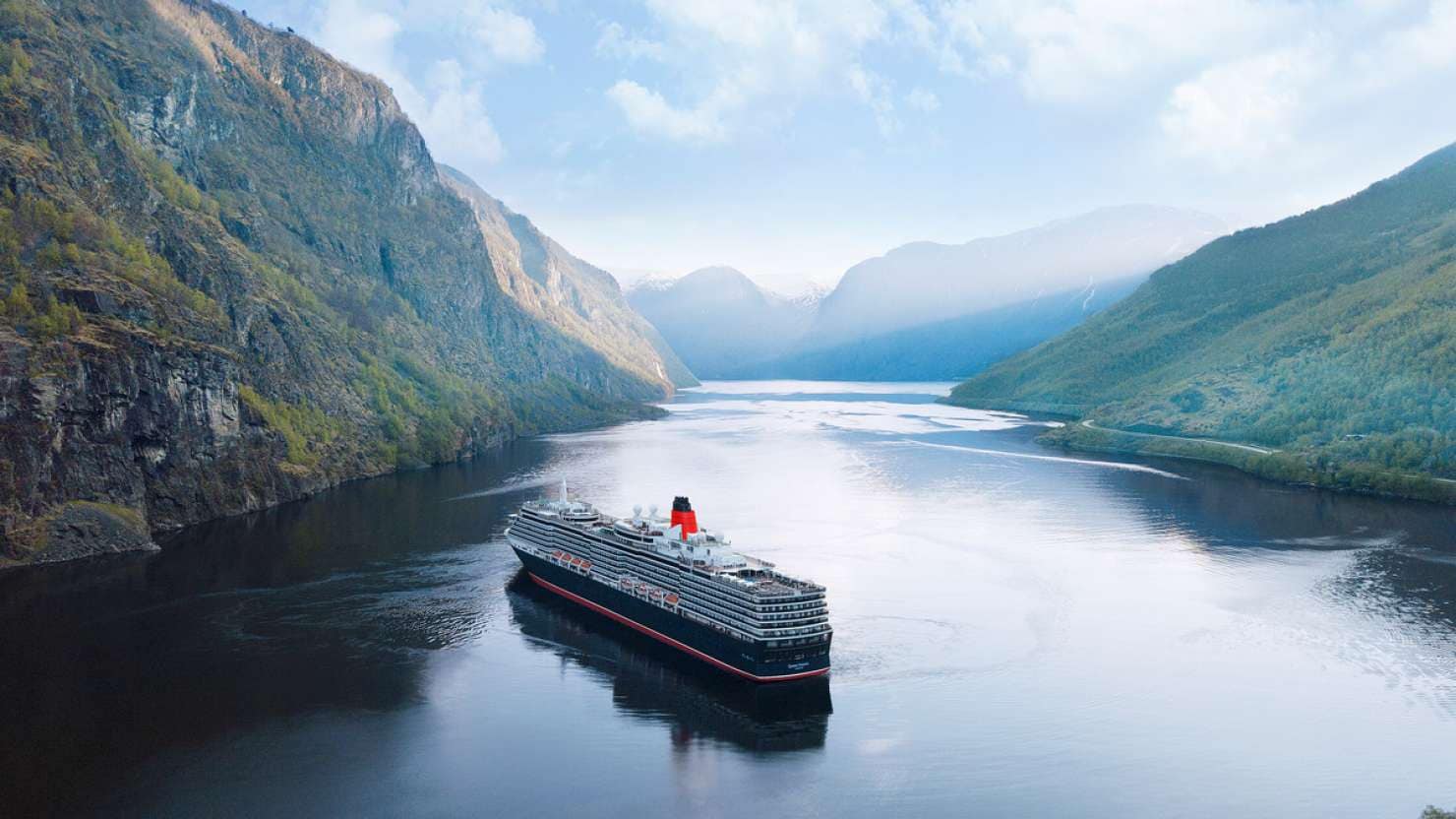ヨーロッパで複数の国を効率的に訪れる方法
Discover Cunard destinations

有名なノルウェーフィヨルドから、ニュージーランドや南米の壮大な氷河まで、自然界で最も美しいスポットをキュナードのフィヨルドクルーズで訪れてみましょう。
ノルウェー西部にある世界で2番目に長いフィヨルド(ソグネフィヨルド)の支流であるアウルランフィヨルドをクルージング。頭上を見上げてその自然美を堪能しましょう。
アウルランフィヨルドの幅はわずか2km。花崗岩の崖には、1,800mもの高さまで松の森がびっしりと続き、雪をかぶった緩やかな頂上へと続いています。よく見ると、きらめくクモの巣から垂れた糸のような、美しい銀色の滝が岩面を流れ落ちているのが見えます。
アウルランフィヨルドとユネスコ世界遺産のネーロイフィヨルドとを区切っているベイテレン山は特に雄大です。フィヨルドのガラスのように静かな水面から突き出し、他の岩山よりも一歩先に出ているかのように誇らしげにそびえ立っています。

アウルランフィヨルドの最奥部に、フロムという小さな村がひっそりと佇んでいます。水辺にきらめく草地に沿って点在するおもちゃのような木造の家が、人間の生活している唯一の証です。
キュナードの元船長、ピーター・フィルポットが彼の印象を語ってくれました。「ノルウェーのクルーズでは、最も素晴らしい景色を見ることができます。山を覆う霧の中でも、太陽の光が降り注ぐ晴天の日でも、フィヨルドの真ん中を航海し、その輝かしい姿を目にすることができます。見晴らしの良い場所からは、両側の山の形を一度に見ることができます。実に素晴らしい光景です。進むにつれて、光が劇的に変化していきます。」
アイスランド北西部、ウエストフィヨルド地方にある、イーサフィヨルズルの壮麗な魅力は、自然の静けさとユニークな立地にあります。
16世紀から続いている交易所で、現在はアイスランド最大の漁場の一つであるこの町は、そびえ立つ山々とカーブを描く黒砂に囲まれ、氷のように冷たい穏やかな海に突き出たアーチ型の礫質土の上に佇んでいます。
亜北極に近いツンドラ気候で、夏の気温は10℃ほどになります。ホエールウォッチングに最適なこの海は、ツノメドリやアザラシ、ホッキョクギツネなど、現地の野生動物を観察するのに絶好のロケーションです。

イーサフィヨルズルの中心部は、通りが碁盤の目のように配置され、素朴な木造家屋が建ち並ぶ魅力的な地区です。ここには、18世紀半ばに建てられた国内最古の木造家屋もあります。ウエストフィヨルド歴史博物館は、1784年に建てられた倉庫内にあり、かつての漁の道具や遺物が展示されています。現在、この街は活気あるアートシーンで賑わい、創造性豊かな人々が地元で暮らしています。年間を通してアートの展示が行われ、キュナードにとっても特別な目的地となっています。
キュナードで全長約43.5kmのトレイシー・アーム・フィヨルドへ、大自然のアドベンチャーに出かけましょう。
トレイシー・アームの突き当たりまでたどり着くと、この上ないほどの青みを帯びたサウス・ソーヤー氷河の美しさを目にすることでしょう。光り輝く巨大な氷の塊が割れ、大きくとどろく音を立てて静かな海へ落ちていく様子をご覧ください。
キュナードのシニアクルーズプログラム開発マネージャー、ジェームズ・ボンフィールドは次のように述べています。「カービングとは氷の塊が氷河の表面から轟音を立てて海に落ちていく現象を指します。そのサイズは乗用車から大型船までさまざまですが、この光景は壮観です。トレイシー・アーム・フィヨルドは最も深い場所で約183mの深さがあるため、水中でカービングが起こることもあります。カービングが起こっても氷はその形を保ちます。その結果、巨大な氷山が作られることになるのです。最大規模の氷山はアラスカで見られます。」

そんな氷の島に遊び好きのアザラシがお腹を使って乗り上げ、ザトウクジラが氷のかけらの間を縫って泳ぎニシンにありつく。この動物たちの慌ただしい活動は、太陽が夜に2時間だけ沈む夏は最長で1日21時間続きます。
双眼鏡を持って、長い冬眠の後に足を伸ばしているクマや280種類もの野鳥を見つけましょう。
このフィヨルドはアラスカの州都ジュノーから南へ約72kmの場所にありますが、この約150万km²の広大な州の人口はたった74万人のため、純粋な自然と荘厳な静けさに浸っていただけます。
フィヨルドランド国立公園の手つかずの絶景は、スケールが大きく息をのむような美しさです。
広さ1,200km²のこの大自然は数々の名声を誇っています。映画『ロード・オブ・ザ・リング』の壮大な舞台として知られるだけでなく、ここには最も規模が大きく、人里離れたフィヨルド、ダウトフル・サウンドがあります。このフィヨルドは1770年にジェームズ・クックによって最初にダウトフル・ハーバーと名付けられました。彼は航行できないことを恐れて、このフィヨルドには入らずに通り過ぎました。
ダウトフル・サウンドは、南限に位置するバンドウイルカの最大級の生息地でもあり、約60頭がここで暮らしています。キュナードの船旅中にも、しばしばその姿を見ることができます。雪をかぶったギザギザのピラミッドのような切り立った崖が特徴のもう一つの巨大なフィヨルド、ミルフォード・サウンドでも、バンドウイルカを見かけることがあります。
マオリの伝説では、半神半人のトゥ・テ・ラキ・ファノアがこの荒涼とした風景を彫り上げ、形のない岩を芸術へと昇華させたと言われています。

「初めてクイーン・ヴィクトリアでここを訪れた時、ミルフォード・サウンドの穏やかさと荘厳さに驚きました。私たちの周りは暗い影で覆われ、周囲の山の尾根から霧が降りていました。ゆっくりと回頭すると、大きな滝が船首の周りに打ち付けてきたのです。素晴らしい光景でした。」
- キュナード、クイーン・ヴィクトリア船長、サイモン・ラブ
アマリア氷河は、ベルナルド・オイギンス国立公園にある潮水氷河で、スクア氷河とも呼ばれ、打ち寄せる大波が凍ったまま時が止まったかのような形をしています。
驚きなのは、アマリア氷河は、天候によって常に動いたり、曲がったり、アーチ状になったり、伸びたり、前進したりして、新しい形を描いているということです。

その前では、好奇心の強いイルカが遊んでいたり、カワウソが水中に入ったり飛び込んだり。一方、アンデス・コンドル(コンドル科に属し、翼幅は3mにもなります)は獲物を狙って空高くヘリコプターのように飛んでいます。休火山であるレクルス火山に隣接するアマリア氷河に近づくと、氷河が動くゴロゴロという音が聞こえてきます。それはまるで、太陽の下で巨大な青い獣が昼寝をしているかのような音です。
ピオ11世氷河は南アメリカ最大、南パタゴニア氷原から西へ流れ出る最大の氷河であり、実際に成長している世界で唯一の氷河です。
この氷河が高さ、長さ、密度において毎日50m成長しているということは、パタゴニアや北極圏を含む世界のほとんどの地域にある氷河とは異なるということを意味しています。氷河の重みで氷から気泡を押し出しているため、この世のものとは思えないような青い色をしています。

この氷河はエイレフィヨルドの最奥部にそびえ立っており、東側にはファルコンとエクスマウスという2つのフィヨルドもあります。フィヨルドという言葉は、ノルド語で氷河によって形成された険しい斜面を両側に持つ狭い入り江」という意味です。この壮大な氷の壁を見ると、この言葉がまだ生まれていない数千年前にタイムスリップしたかのような気分を味わえます。
of
キュナードでは、最新のクルーズ情報、弊社に関するニュースやお得な情報などを配信しております。受信を希望される方は、お客様の敬称をご選択の上、お名前、メールアドレスを半角ローマ字で入力してください。同意のチェックボックスに✓を入れてから「登録する」をクリックしていただくとお手続きが完了します。